Chronic Illness Interview Essay: Applying Nursing Models and Care
VerifiedAdded on 2022/08/25
|12
|3232
|16
Essay
AI Summary
This essay presents an analysis of a chronic illness case, focusing on an interview with an individual suffering from a spinal cord injury. The essay explores the impact of the injury on the interviewee's life, family, and overall well-being, including the challenges of pain management, mobility limitations, and social isolation. The student applies the Roper, Logan, and Tierney (RLT) model of nursing and the Levett-Jones Clinical Reasoning Cycle to identify nursing care priorities and goals. The discussion covers the interviewee's experience, the application of nursing models, and the identification of key care priorities, such as pain management and mobility support, supported by relevant literature. The essay concludes by emphasizing the importance of understanding chronic illness and the need for comprehensive nursing care plans.
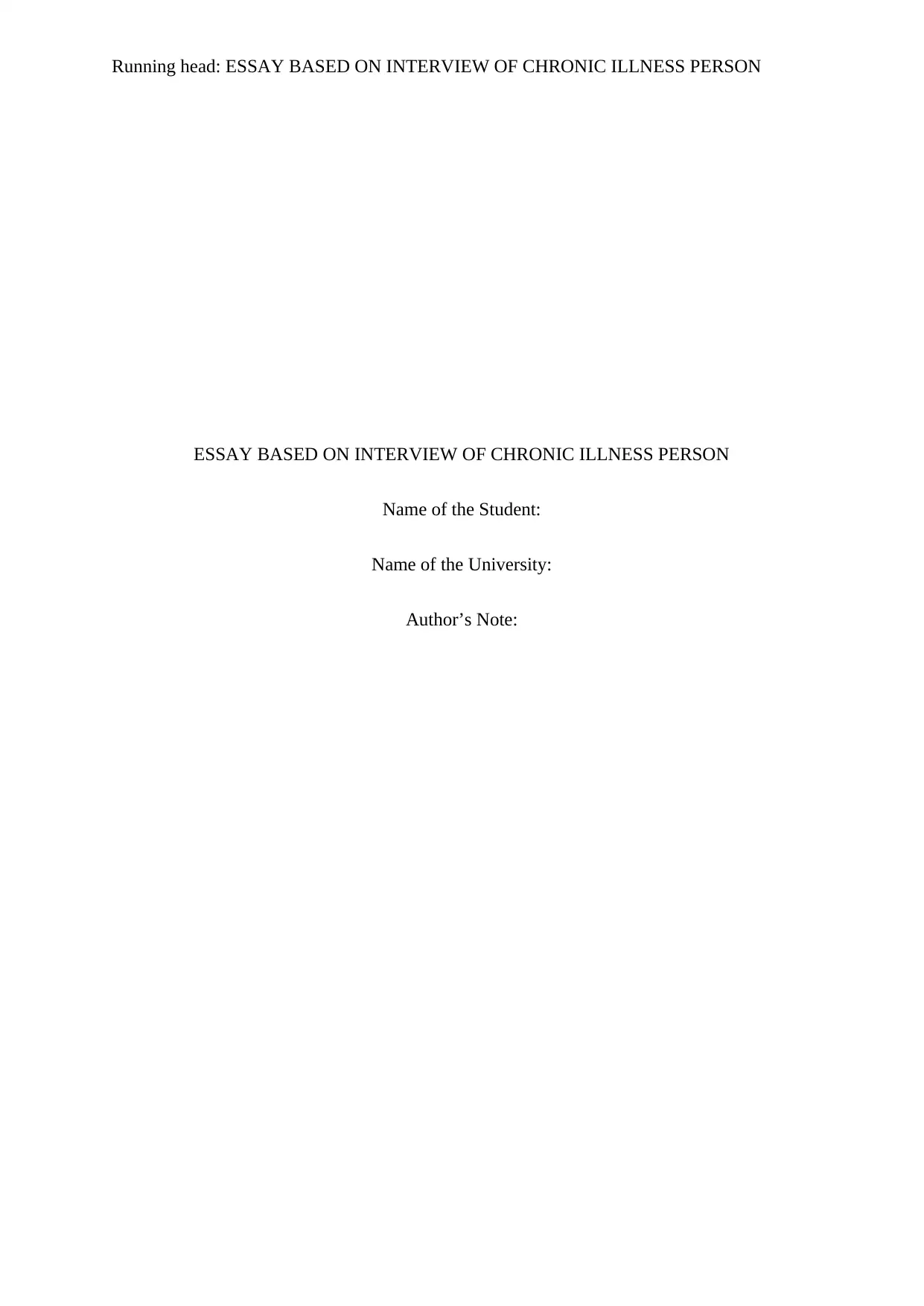
Running head: ESSAY BASED ON INTERVIEW OF CHRONIC ILLNESS PERSON
ESSAY BASED ON INTERVIEW OF CHRONIC ILLNESS PERSON
Name of the Student:
Name of the University:
Author’s Note:
ESSAY BASED ON INTERVIEW OF CHRONIC ILLNESS PERSON
Name of the Student:
Name of the University:
Author’s Note:
Paraphrase This Document
Need a fresh take? Get an instant paraphrase of this document with our AI Paraphraser
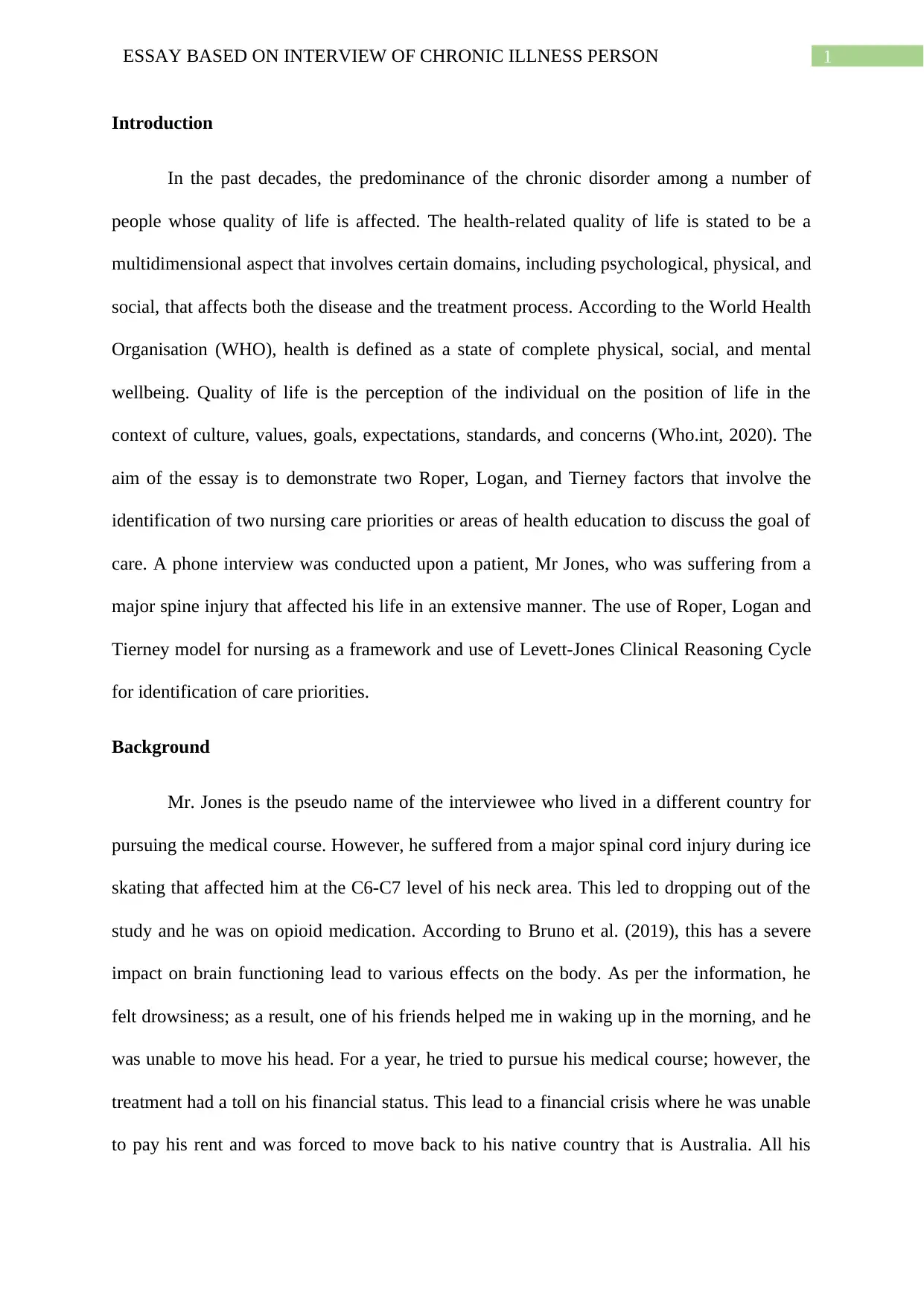
1ESSAY BASED ON INTERVIEW OF CHRONIC ILLNESS PERSON
Introduction
In the past decades, the predominance of the chronic disorder among a number of
people whose quality of life is affected. The health-related quality of life is stated to be a
multidimensional aspect that involves certain domains, including psychological, physical, and
social, that affects both the disease and the treatment process. According to the World Health
Organisation (WHO), health is defined as a state of complete physical, social, and mental
wellbeing. Quality of life is the perception of the individual on the position of life in the
context of culture, values, goals, expectations, standards, and concerns (Who.int, 2020). The
aim of the essay is to demonstrate two Roper, Logan, and Tierney factors that involve the
identification of two nursing care priorities or areas of health education to discuss the goal of
care. A phone interview was conducted upon a patient, Mr Jones, who was suffering from a
major spine injury that affected his life in an extensive manner. The use of Roper, Logan and
Tierney model for nursing as a framework and use of Levett-Jones Clinical Reasoning Cycle
for identification of care priorities.
Background
Mr. Jones is the pseudo name of the interviewee who lived in a different country for
pursuing the medical course. However, he suffered from a major spinal cord injury during ice
skating that affected him at the C6-C7 level of his neck area. This led to dropping out of the
study and he was on opioid medication. According to Bruno et al. (2019), this has a severe
impact on brain functioning lead to various effects on the body. As per the information, he
felt drowsiness; as a result, one of his friends helped me in waking up in the morning, and he
was unable to move his head. For a year, he tried to pursue his medical course; however, the
treatment had a toll on his financial status. This lead to a financial crisis where he was unable
to pay his rent and was forced to move back to his native country that is Australia. All his
Introduction
In the past decades, the predominance of the chronic disorder among a number of
people whose quality of life is affected. The health-related quality of life is stated to be a
multidimensional aspect that involves certain domains, including psychological, physical, and
social, that affects both the disease and the treatment process. According to the World Health
Organisation (WHO), health is defined as a state of complete physical, social, and mental
wellbeing. Quality of life is the perception of the individual on the position of life in the
context of culture, values, goals, expectations, standards, and concerns (Who.int, 2020). The
aim of the essay is to demonstrate two Roper, Logan, and Tierney factors that involve the
identification of two nursing care priorities or areas of health education to discuss the goal of
care. A phone interview was conducted upon a patient, Mr Jones, who was suffering from a
major spine injury that affected his life in an extensive manner. The use of Roper, Logan and
Tierney model for nursing as a framework and use of Levett-Jones Clinical Reasoning Cycle
for identification of care priorities.
Background
Mr. Jones is the pseudo name of the interviewee who lived in a different country for
pursuing the medical course. However, he suffered from a major spinal cord injury during ice
skating that affected him at the C6-C7 level of his neck area. This led to dropping out of the
study and he was on opioid medication. According to Bruno et al. (2019), this has a severe
impact on brain functioning lead to various effects on the body. As per the information, he
felt drowsiness; as a result, one of his friends helped me in waking up in the morning, and he
was unable to move his head. For a year, he tried to pursue his medical course; however, the
treatment had a toll on his financial status. This lead to a financial crisis where he was unable
to pay his rent and was forced to move back to his native country that is Australia. All his
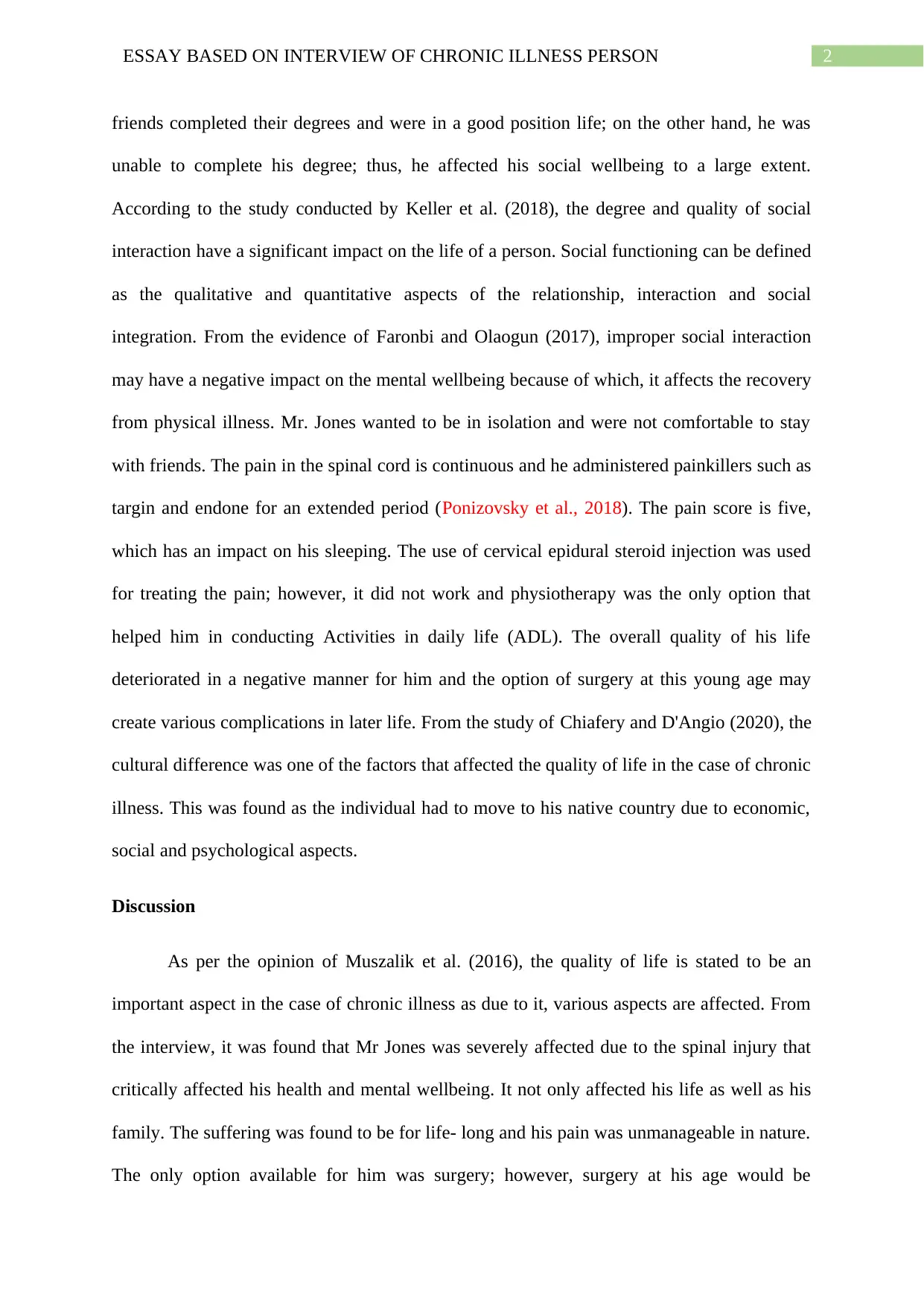
2ESSAY BASED ON INTERVIEW OF CHRONIC ILLNESS PERSON
friends completed their degrees and were in a good position life; on the other hand, he was
unable to complete his degree; thus, he affected his social wellbeing to a large extent.
According to the study conducted by Keller et al. (2018), the degree and quality of social
interaction have a significant impact on the life of a person. Social functioning can be defined
as the qualitative and quantitative aspects of the relationship, interaction and social
integration. From the evidence of Faronbi and Olaogun (2017), improper social interaction
may have a negative impact on the mental wellbeing because of which, it affects the recovery
from physical illness. Mr. Jones wanted to be in isolation and were not comfortable to stay
with friends. The pain in the spinal cord is continuous and he administered painkillers such as
targin and endone for an extended period (Ponizovsky et al., 2018). The pain score is five,
which has an impact on his sleeping. The use of cervical epidural steroid injection was used
for treating the pain; however, it did not work and physiotherapy was the only option that
helped him in conducting Activities in daily life (ADL). The overall quality of his life
deteriorated in a negative manner for him and the option of surgery at this young age may
create various complications in later life. From the study of Chiafery and D'Angio (2020), the
cultural difference was one of the factors that affected the quality of life in the case of chronic
illness. This was found as the individual had to move to his native country due to economic,
social and psychological aspects.
Discussion
As per the opinion of Muszalik et al. (2016), the quality of life is stated to be an
important aspect in the case of chronic illness as due to it, various aspects are affected. From
the interview, it was found that Mr Jones was severely affected due to the spinal injury that
critically affected his health and mental wellbeing. It not only affected his life as well as his
family. The suffering was found to be for life- long and his pain was unmanageable in nature.
The only option available for him was surgery; however, surgery at his age would be
friends completed their degrees and were in a good position life; on the other hand, he was
unable to complete his degree; thus, he affected his social wellbeing to a large extent.
According to the study conducted by Keller et al. (2018), the degree and quality of social
interaction have a significant impact on the life of a person. Social functioning can be defined
as the qualitative and quantitative aspects of the relationship, interaction and social
integration. From the evidence of Faronbi and Olaogun (2017), improper social interaction
may have a negative impact on the mental wellbeing because of which, it affects the recovery
from physical illness. Mr. Jones wanted to be in isolation and were not comfortable to stay
with friends. The pain in the spinal cord is continuous and he administered painkillers such as
targin and endone for an extended period (Ponizovsky et al., 2018). The pain score is five,
which has an impact on his sleeping. The use of cervical epidural steroid injection was used
for treating the pain; however, it did not work and physiotherapy was the only option that
helped him in conducting Activities in daily life (ADL). The overall quality of his life
deteriorated in a negative manner for him and the option of surgery at this young age may
create various complications in later life. From the study of Chiafery and D'Angio (2020), the
cultural difference was one of the factors that affected the quality of life in the case of chronic
illness. This was found as the individual had to move to his native country due to economic,
social and psychological aspects.
Discussion
As per the opinion of Muszalik et al. (2016), the quality of life is stated to be an
important aspect in the case of chronic illness as due to it, various aspects are affected. From
the interview, it was found that Mr Jones was severely affected due to the spinal injury that
critically affected his health and mental wellbeing. It not only affected his life as well as his
family. The suffering was found to be for life- long and his pain was unmanageable in nature.
The only option available for him was surgery; however, surgery at his age would be
⊘ This is a preview!⊘
Do you want full access?
Subscribe today to unlock all pages.

Trusted by 1+ million students worldwide
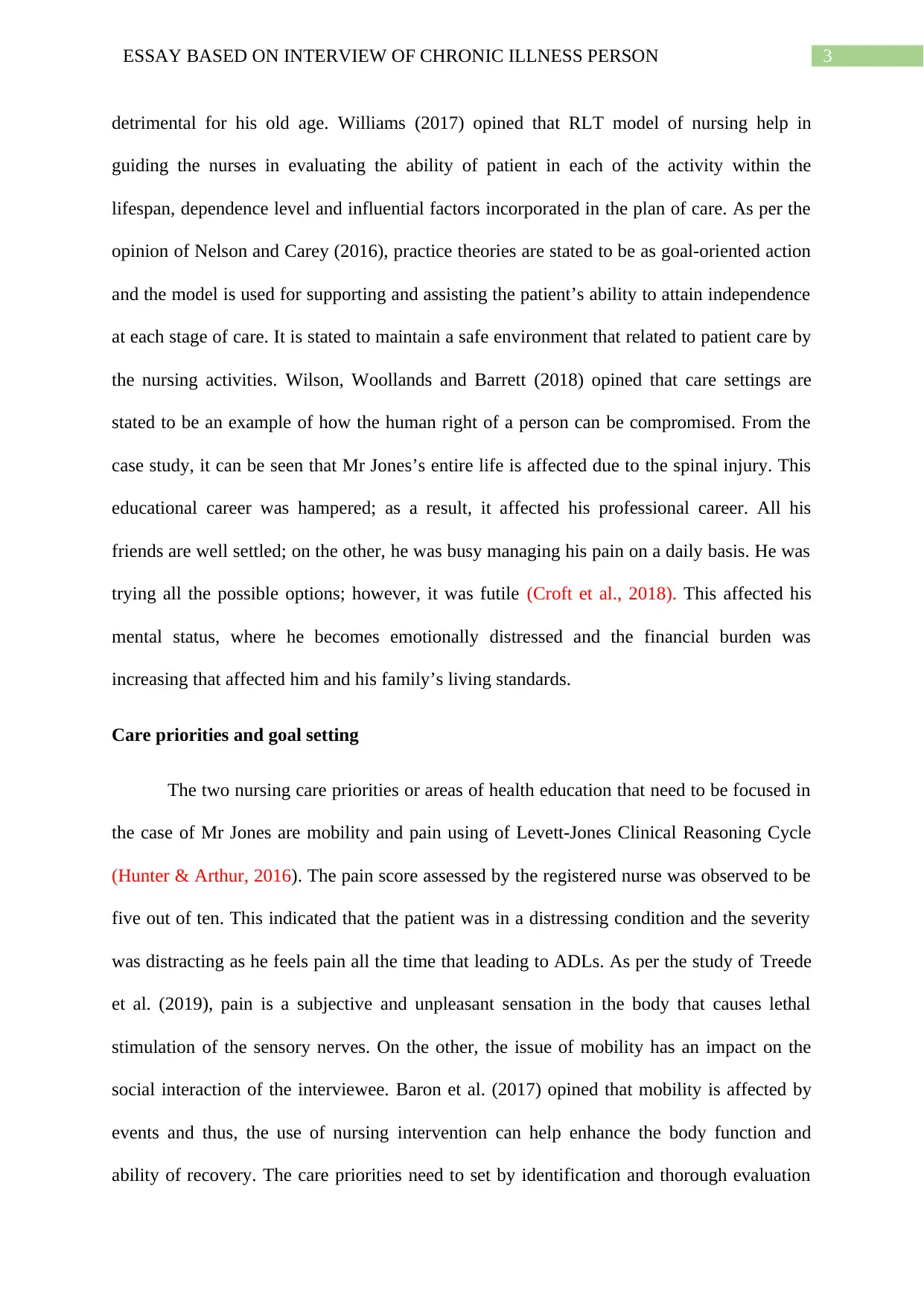
3ESSAY BASED ON INTERVIEW OF CHRONIC ILLNESS PERSON
detrimental for his old age. Williams (2017) opined that RLT model of nursing help in
guiding the nurses in evaluating the ability of patient in each of the activity within the
lifespan, dependence level and influential factors incorporated in the plan of care. As per the
opinion of Nelson and Carey (2016), practice theories are stated to be as goal-oriented action
and the model is used for supporting and assisting the patient’s ability to attain independence
at each stage of care. It is stated to maintain a safe environment that related to patient care by
the nursing activities. Wilson, Woollands and Barrett (2018) opined that care settings are
stated to be an example of how the human right of a person can be compromised. From the
case study, it can be seen that Mr Jones’s entire life is affected due to the spinal injury. This
educational career was hampered; as a result, it affected his professional career. All his
friends are well settled; on the other, he was busy managing his pain on a daily basis. He was
trying all the possible options; however, it was futile (Croft et al., 2018). This affected his
mental status, where he becomes emotionally distressed and the financial burden was
increasing that affected him and his family’s living standards.
Care priorities and goal setting
The two nursing care priorities or areas of health education that need to be focused in
the case of Mr Jones are mobility and pain using of Levett-Jones Clinical Reasoning Cycle
(Hunter & Arthur, 2016). The pain score assessed by the registered nurse was observed to be
five out of ten. This indicated that the patient was in a distressing condition and the severity
was distracting as he feels pain all the time that leading to ADLs. As per the study of Treede
et al. (2019), pain is a subjective and unpleasant sensation in the body that causes lethal
stimulation of the sensory nerves. On the other, the issue of mobility has an impact on the
social interaction of the interviewee. Baron et al. (2017) opined that mobility is affected by
events and thus, the use of nursing intervention can help enhance the body function and
ability of recovery. The care priorities need to set by identification and thorough evaluation
detrimental for his old age. Williams (2017) opined that RLT model of nursing help in
guiding the nurses in evaluating the ability of patient in each of the activity within the
lifespan, dependence level and influential factors incorporated in the plan of care. As per the
opinion of Nelson and Carey (2016), practice theories are stated to be as goal-oriented action
and the model is used for supporting and assisting the patient’s ability to attain independence
at each stage of care. It is stated to maintain a safe environment that related to patient care by
the nursing activities. Wilson, Woollands and Barrett (2018) opined that care settings are
stated to be an example of how the human right of a person can be compromised. From the
case study, it can be seen that Mr Jones’s entire life is affected due to the spinal injury. This
educational career was hampered; as a result, it affected his professional career. All his
friends are well settled; on the other, he was busy managing his pain on a daily basis. He was
trying all the possible options; however, it was futile (Croft et al., 2018). This affected his
mental status, where he becomes emotionally distressed and the financial burden was
increasing that affected him and his family’s living standards.
Care priorities and goal setting
The two nursing care priorities or areas of health education that need to be focused in
the case of Mr Jones are mobility and pain using of Levett-Jones Clinical Reasoning Cycle
(Hunter & Arthur, 2016). The pain score assessed by the registered nurse was observed to be
five out of ten. This indicated that the patient was in a distressing condition and the severity
was distracting as he feels pain all the time that leading to ADLs. As per the study of Treede
et al. (2019), pain is a subjective and unpleasant sensation in the body that causes lethal
stimulation of the sensory nerves. On the other, the issue of mobility has an impact on the
social interaction of the interviewee. Baron et al. (2017) opined that mobility is affected by
events and thus, the use of nursing intervention can help enhance the body function and
ability of recovery. The care priorities need to set by identification and thorough evaluation
Paraphrase This Document
Need a fresh take? Get an instant paraphrase of this document with our AI Paraphraser
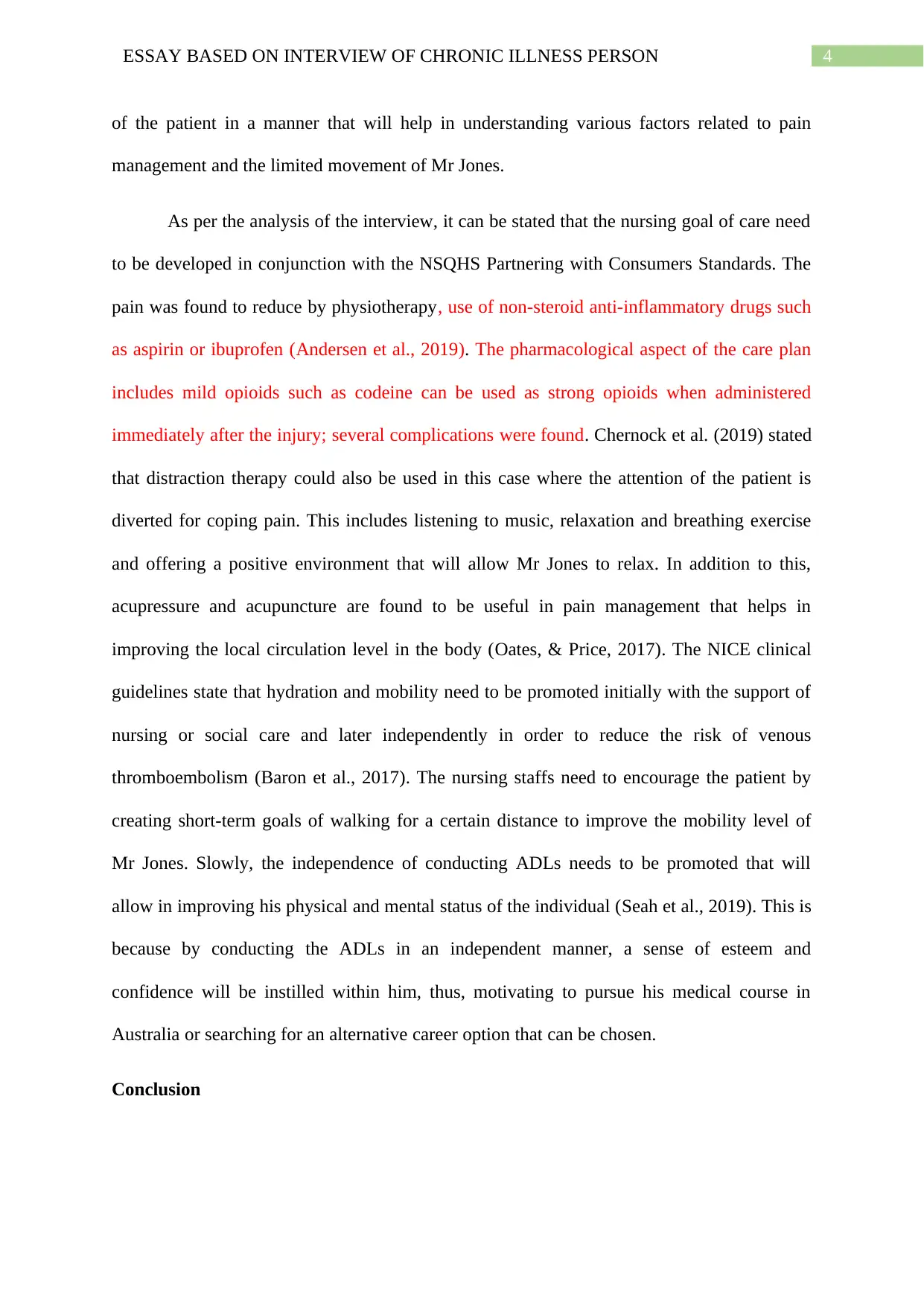
4ESSAY BASED ON INTERVIEW OF CHRONIC ILLNESS PERSON
of the patient in a manner that will help in understanding various factors related to pain
management and the limited movement of Mr Jones.
As per the analysis of the interview, it can be stated that the nursing goal of care need
to be developed in conjunction with the NSQHS Partnering with Consumers Standards. The
pain was found to reduce by physiotherapy, use of non-steroid anti-inflammatory drugs such
as aspirin or ibuprofen (Andersen et al., 2019). The pharmacological aspect of the care plan
includes mild opioids such as codeine can be used as strong opioids when administered
immediately after the injury; several complications were found. Chernock et al. (2019) stated
that distraction therapy could also be used in this case where the attention of the patient is
diverted for coping pain. This includes listening to music, relaxation and breathing exercise
and offering a positive environment that will allow Mr Jones to relax. In addition to this,
acupressure and acupuncture are found to be useful in pain management that helps in
improving the local circulation level in the body (Oates, & Price, 2017). The NICE clinical
guidelines state that hydration and mobility need to be promoted initially with the support of
nursing or social care and later independently in order to reduce the risk of venous
thromboembolism (Baron et al., 2017). The nursing staffs need to encourage the patient by
creating short-term goals of walking for a certain distance to improve the mobility level of
Mr Jones. Slowly, the independence of conducting ADLs needs to be promoted that will
allow in improving his physical and mental status of the individual (Seah et al., 2019). This is
because by conducting the ADLs in an independent manner, a sense of esteem and
confidence will be instilled within him, thus, motivating to pursue his medical course in
Australia or searching for an alternative career option that can be chosen.
Conclusion
of the patient in a manner that will help in understanding various factors related to pain
management and the limited movement of Mr Jones.
As per the analysis of the interview, it can be stated that the nursing goal of care need
to be developed in conjunction with the NSQHS Partnering with Consumers Standards. The
pain was found to reduce by physiotherapy, use of non-steroid anti-inflammatory drugs such
as aspirin or ibuprofen (Andersen et al., 2019). The pharmacological aspect of the care plan
includes mild opioids such as codeine can be used as strong opioids when administered
immediately after the injury; several complications were found. Chernock et al. (2019) stated
that distraction therapy could also be used in this case where the attention of the patient is
diverted for coping pain. This includes listening to music, relaxation and breathing exercise
and offering a positive environment that will allow Mr Jones to relax. In addition to this,
acupressure and acupuncture are found to be useful in pain management that helps in
improving the local circulation level in the body (Oates, & Price, 2017). The NICE clinical
guidelines state that hydration and mobility need to be promoted initially with the support of
nursing or social care and later independently in order to reduce the risk of venous
thromboembolism (Baron et al., 2017). The nursing staffs need to encourage the patient by
creating short-term goals of walking for a certain distance to improve the mobility level of
Mr Jones. Slowly, the independence of conducting ADLs needs to be promoted that will
allow in improving his physical and mental status of the individual (Seah et al., 2019). This is
because by conducting the ADLs in an independent manner, a sense of esteem and
confidence will be instilled within him, thus, motivating to pursue his medical course in
Australia or searching for an alternative career option that can be chosen.
Conclusion
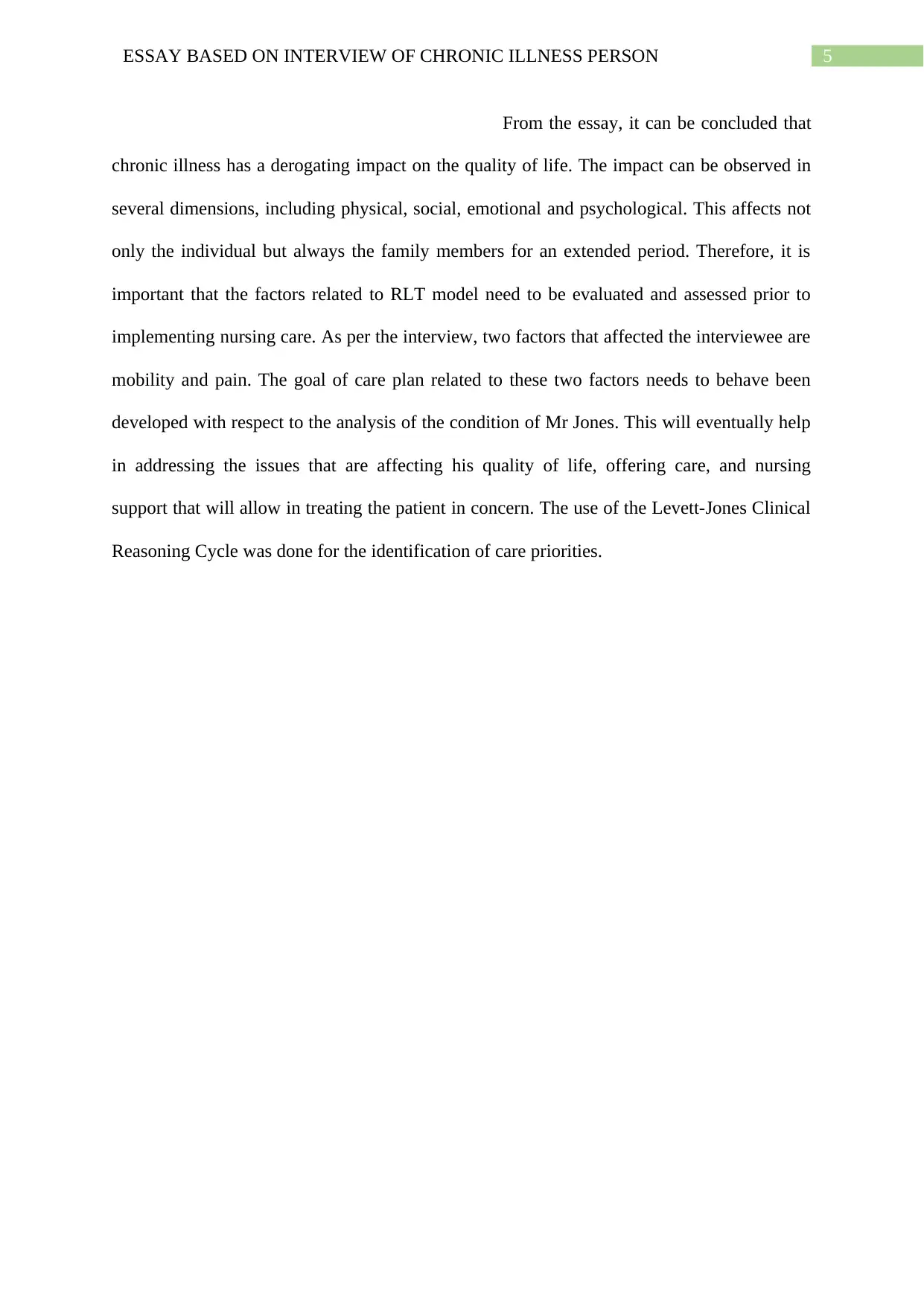
5ESSAY BASED ON INTERVIEW OF CHRONIC ILLNESS PERSON
From the essay, it can be concluded that
chronic illness has a derogating impact on the quality of life. The impact can be observed in
several dimensions, including physical, social, emotional and psychological. This affects not
only the individual but always the family members for an extended period. Therefore, it is
important that the factors related to RLT model need to be evaluated and assessed prior to
implementing nursing care. As per the interview, two factors that affected the interviewee are
mobility and pain. The goal of care plan related to these two factors needs to behave been
developed with respect to the analysis of the condition of Mr Jones. This will eventually help
in addressing the issues that are affecting his quality of life, offering care, and nursing
support that will allow in treating the patient in concern. The use of the Levett-Jones Clinical
Reasoning Cycle was done for the identification of care priorities.
From the essay, it can be concluded that
chronic illness has a derogating impact on the quality of life. The impact can be observed in
several dimensions, including physical, social, emotional and psychological. This affects not
only the individual but always the family members for an extended period. Therefore, it is
important that the factors related to RLT model need to be evaluated and assessed prior to
implementing nursing care. As per the interview, two factors that affected the interviewee are
mobility and pain. The goal of care plan related to these two factors needs to behave been
developed with respect to the analysis of the condition of Mr Jones. This will eventually help
in addressing the issues that are affecting his quality of life, offering care, and nursing
support that will allow in treating the patient in concern. The use of the Levett-Jones Clinical
Reasoning Cycle was done for the identification of care priorities.
⊘ This is a preview!⊘
Do you want full access?
Subscribe today to unlock all pages.

Trusted by 1+ million students worldwide
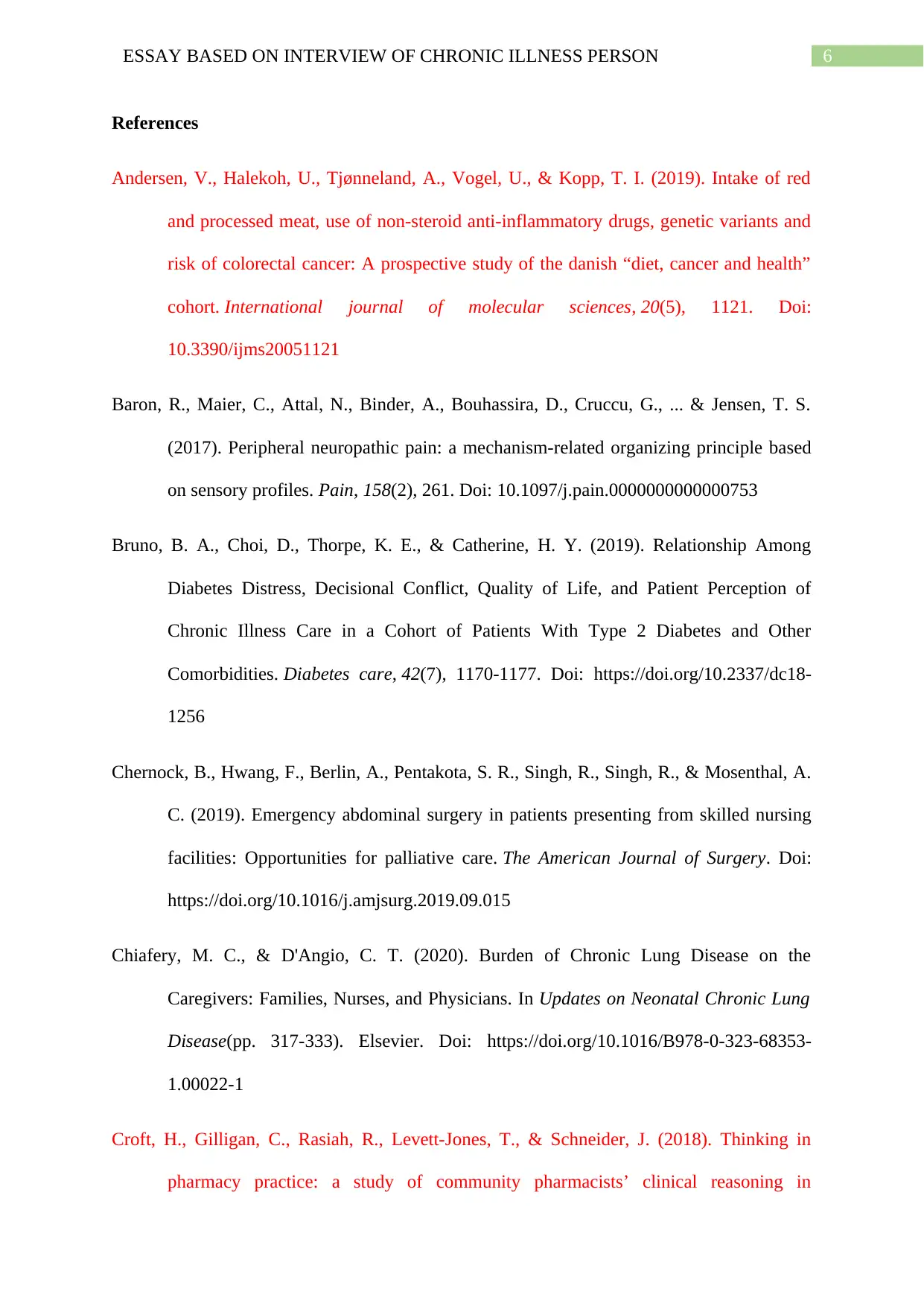
6ESSAY BASED ON INTERVIEW OF CHRONIC ILLNESS PERSON
References
Andersen, V., Halekoh, U., Tjønneland, A., Vogel, U., & Kopp, T. I. (2019). Intake of red
and processed meat, use of non-steroid anti-inflammatory drugs, genetic variants and
risk of colorectal cancer: A prospective study of the danish “diet, cancer and health”
cohort. International journal of molecular sciences, 20(5), 1121. Doi:
10.3390/ijms20051121
Baron, R., Maier, C., Attal, N., Binder, A., Bouhassira, D., Cruccu, G., ... & Jensen, T. S.
(2017). Peripheral neuropathic pain: a mechanism-related organizing principle based
on sensory profiles. Pain, 158(2), 261. Doi: 10.1097/j.pain.0000000000000753
Bruno, B. A., Choi, D., Thorpe, K. E., & Catherine, H. Y. (2019). Relationship Among
Diabetes Distress, Decisional Conflict, Quality of Life, and Patient Perception of
Chronic Illness Care in a Cohort of Patients With Type 2 Diabetes and Other
Comorbidities. Diabetes care, 42(7), 1170-1177. Doi: https://doi.org/10.2337/dc18-
1256
Chernock, B., Hwang, F., Berlin, A., Pentakota, S. R., Singh, R., Singh, R., & Mosenthal, A.
C. (2019). Emergency abdominal surgery in patients presenting from skilled nursing
facilities: Opportunities for palliative care. The American Journal of Surgery. Doi:
https://doi.org/10.1016/j.amjsurg.2019.09.015
Chiafery, M. C., & D'Angio, C. T. (2020). Burden of Chronic Lung Disease on the
Caregivers: Families, Nurses, and Physicians. In Updates on Neonatal Chronic Lung
Disease(pp. 317-333). Elsevier. Doi: https://doi.org/10.1016/B978-0-323-68353-
1.00022-1
Croft, H., Gilligan, C., Rasiah, R., Levett-Jones, T., & Schneider, J. (2018). Thinking in
pharmacy practice: a study of community pharmacists’ clinical reasoning in
References
Andersen, V., Halekoh, U., Tjønneland, A., Vogel, U., & Kopp, T. I. (2019). Intake of red
and processed meat, use of non-steroid anti-inflammatory drugs, genetic variants and
risk of colorectal cancer: A prospective study of the danish “diet, cancer and health”
cohort. International journal of molecular sciences, 20(5), 1121. Doi:
10.3390/ijms20051121
Baron, R., Maier, C., Attal, N., Binder, A., Bouhassira, D., Cruccu, G., ... & Jensen, T. S.
(2017). Peripheral neuropathic pain: a mechanism-related organizing principle based
on sensory profiles. Pain, 158(2), 261. Doi: 10.1097/j.pain.0000000000000753
Bruno, B. A., Choi, D., Thorpe, K. E., & Catherine, H. Y. (2019). Relationship Among
Diabetes Distress, Decisional Conflict, Quality of Life, and Patient Perception of
Chronic Illness Care in a Cohort of Patients With Type 2 Diabetes and Other
Comorbidities. Diabetes care, 42(7), 1170-1177. Doi: https://doi.org/10.2337/dc18-
1256
Chernock, B., Hwang, F., Berlin, A., Pentakota, S. R., Singh, R., Singh, R., & Mosenthal, A.
C. (2019). Emergency abdominal surgery in patients presenting from skilled nursing
facilities: Opportunities for palliative care. The American Journal of Surgery. Doi:
https://doi.org/10.1016/j.amjsurg.2019.09.015
Chiafery, M. C., & D'Angio, C. T. (2020). Burden of Chronic Lung Disease on the
Caregivers: Families, Nurses, and Physicians. In Updates on Neonatal Chronic Lung
Disease(pp. 317-333). Elsevier. Doi: https://doi.org/10.1016/B978-0-323-68353-
1.00022-1
Croft, H., Gilligan, C., Rasiah, R., Levett-Jones, T., & Schneider, J. (2018). Thinking in
pharmacy practice: a study of community pharmacists’ clinical reasoning in
Paraphrase This Document
Need a fresh take? Get an instant paraphrase of this document with our AI Paraphraser
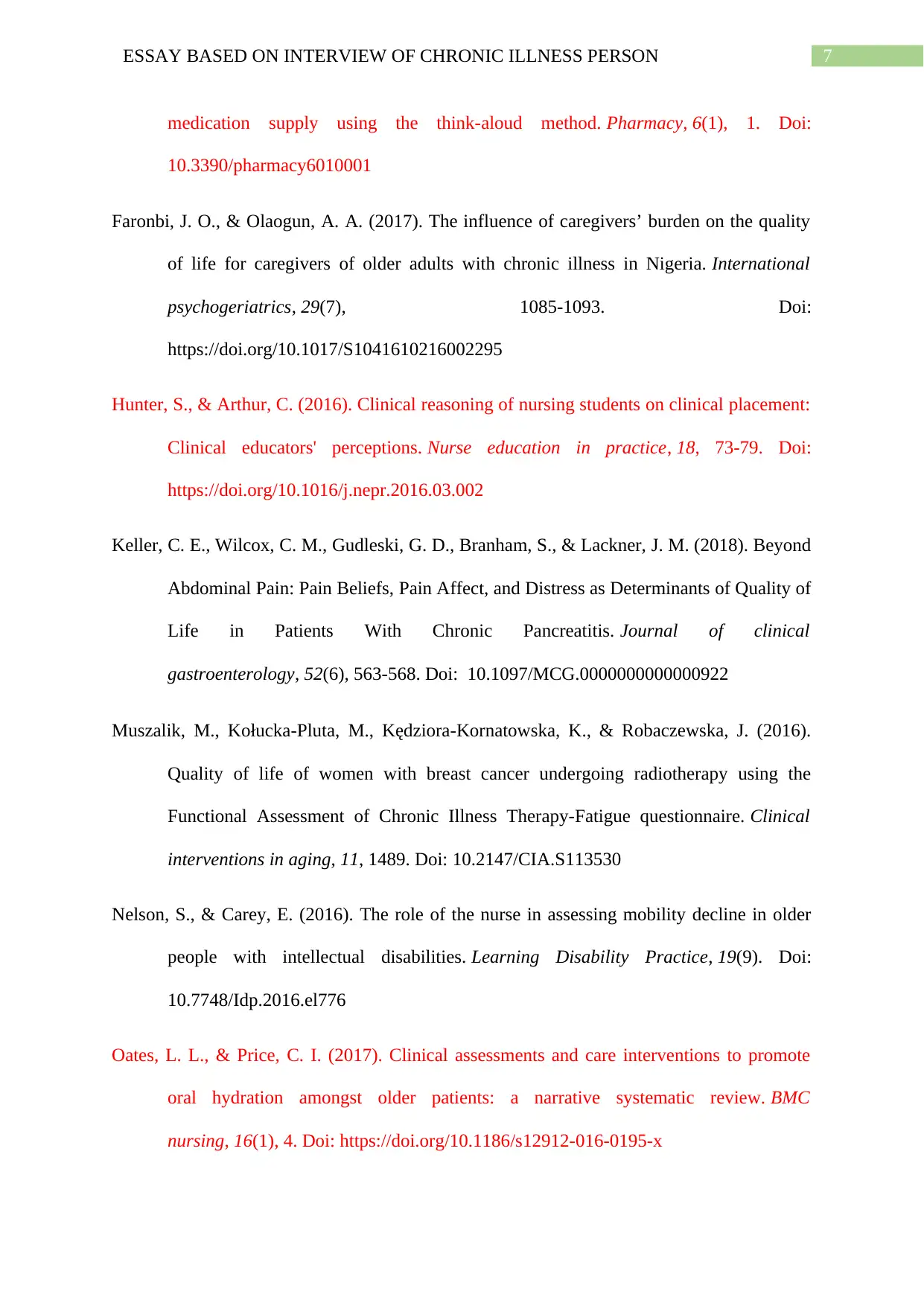
7ESSAY BASED ON INTERVIEW OF CHRONIC ILLNESS PERSON
medication supply using the think-aloud method. Pharmacy, 6(1), 1. Doi:
10.3390/pharmacy6010001
Faronbi, J. O., & Olaogun, A. A. (2017). The influence of caregivers’ burden on the quality
of life for caregivers of older adults with chronic illness in Nigeria. International
psychogeriatrics, 29(7), 1085-1093. Doi:
https://doi.org/10.1017/S1041610216002295
Hunter, S., & Arthur, C. (2016). Clinical reasoning of nursing students on clinical placement:
Clinical educators' perceptions. Nurse education in practice, 18, 73-79. Doi:
https://doi.org/10.1016/j.nepr.2016.03.002
Keller, C. E., Wilcox, C. M., Gudleski, G. D., Branham, S., & Lackner, J. M. (2018). Beyond
Abdominal Pain: Pain Beliefs, Pain Affect, and Distress as Determinants of Quality of
Life in Patients With Chronic Pancreatitis. Journal of clinical
gastroenterology, 52(6), 563-568. Doi: 10.1097/MCG.0000000000000922
Muszalik, M., Kołucka-Pluta, M., Kędziora-Kornatowska, K., & Robaczewska, J. (2016).
Quality of life of women with breast cancer undergoing radiotherapy using the
Functional Assessment of Chronic Illness Therapy-Fatigue questionnaire. Clinical
interventions in aging, 11, 1489. Doi: 10.2147/CIA.S113530
Nelson, S., & Carey, E. (2016). The role of the nurse in assessing mobility decline in older
people with intellectual disabilities. Learning Disability Practice, 19(9). Doi:
10.7748/Idp.2016.el776
Oates, L. L., & Price, C. I. (2017). Clinical assessments and care interventions to promote
oral hydration amongst older patients: a narrative systematic review. BMC
nursing, 16(1), 4. Doi: https://doi.org/10.1186/s12912-016-0195-x
medication supply using the think-aloud method. Pharmacy, 6(1), 1. Doi:
10.3390/pharmacy6010001
Faronbi, J. O., & Olaogun, A. A. (2017). The influence of caregivers’ burden on the quality
of life for caregivers of older adults with chronic illness in Nigeria. International
psychogeriatrics, 29(7), 1085-1093. Doi:
https://doi.org/10.1017/S1041610216002295
Hunter, S., & Arthur, C. (2016). Clinical reasoning of nursing students on clinical placement:
Clinical educators' perceptions. Nurse education in practice, 18, 73-79. Doi:
https://doi.org/10.1016/j.nepr.2016.03.002
Keller, C. E., Wilcox, C. M., Gudleski, G. D., Branham, S., & Lackner, J. M. (2018). Beyond
Abdominal Pain: Pain Beliefs, Pain Affect, and Distress as Determinants of Quality of
Life in Patients With Chronic Pancreatitis. Journal of clinical
gastroenterology, 52(6), 563-568. Doi: 10.1097/MCG.0000000000000922
Muszalik, M., Kołucka-Pluta, M., Kędziora-Kornatowska, K., & Robaczewska, J. (2016).
Quality of life of women with breast cancer undergoing radiotherapy using the
Functional Assessment of Chronic Illness Therapy-Fatigue questionnaire. Clinical
interventions in aging, 11, 1489. Doi: 10.2147/CIA.S113530
Nelson, S., & Carey, E. (2016). The role of the nurse in assessing mobility decline in older
people with intellectual disabilities. Learning Disability Practice, 19(9). Doi:
10.7748/Idp.2016.el776
Oates, L. L., & Price, C. I. (2017). Clinical assessments and care interventions to promote
oral hydration amongst older patients: a narrative systematic review. BMC
nursing, 16(1), 4. Doi: https://doi.org/10.1186/s12912-016-0195-x
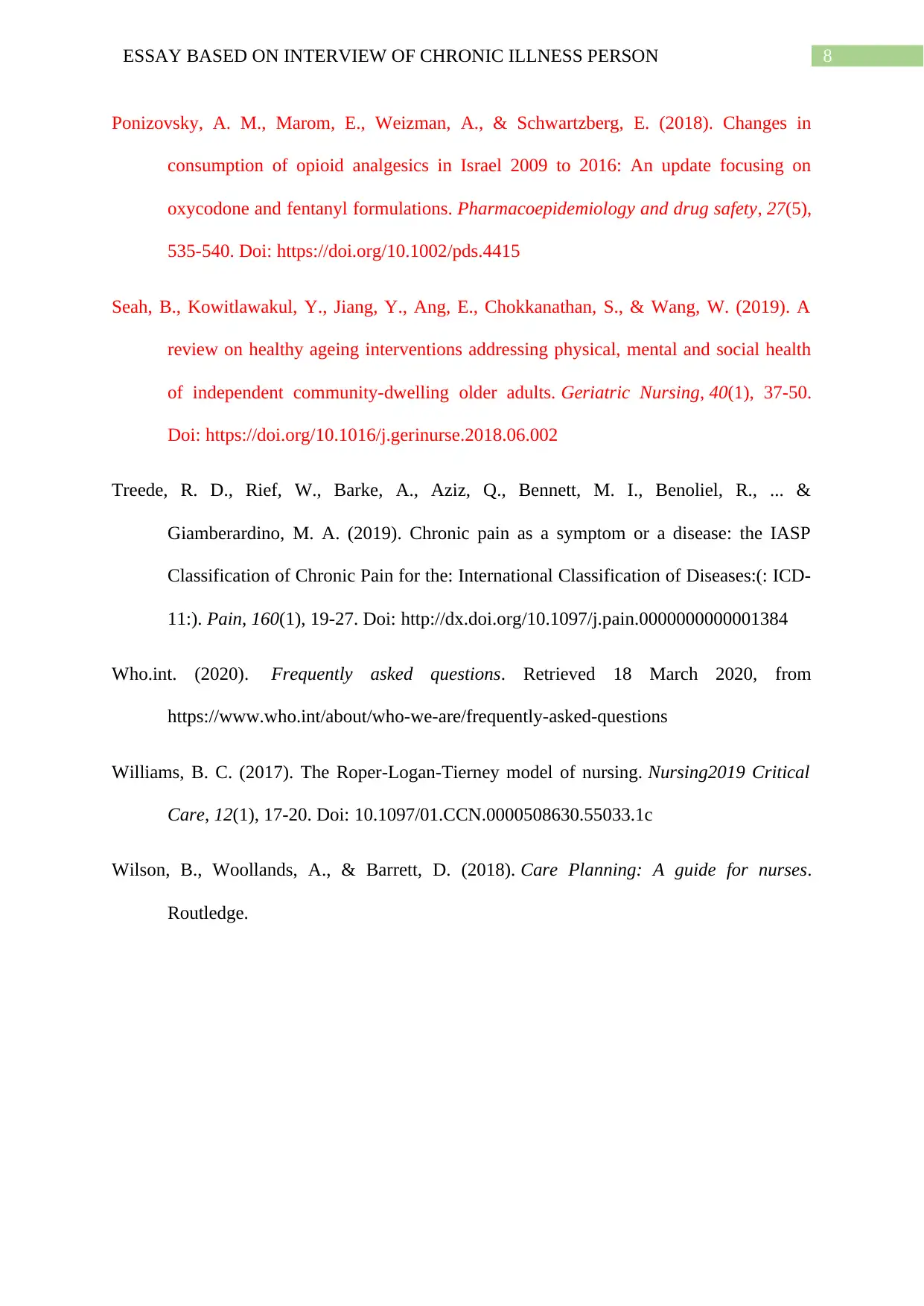
8ESSAY BASED ON INTERVIEW OF CHRONIC ILLNESS PERSON
Ponizovsky, A. M., Marom, E., Weizman, A., & Schwartzberg, E. (2018). Changes in
consumption of opioid analgesics in Israel 2009 to 2016: An update focusing on
oxycodone and fentanyl formulations. Pharmacoepidemiology and drug safety, 27(5),
535-540. Doi: https://doi.org/10.1002/pds.4415
Seah, B., Kowitlawakul, Y., Jiang, Y., Ang, E., Chokkanathan, S., & Wang, W. (2019). A
review on healthy ageing interventions addressing physical, mental and social health
of independent community-dwelling older adults. Geriatric Nursing, 40(1), 37-50.
Doi: https://doi.org/10.1016/j.gerinurse.2018.06.002
Treede, R. D., Rief, W., Barke, A., Aziz, Q., Bennett, M. I., Benoliel, R., ... &
Giamberardino, M. A. (2019). Chronic pain as a symptom or a disease: the IASP
Classification of Chronic Pain for the: International Classification of Diseases:(: ICD-
11:). Pain, 160(1), 19-27. Doi: http://dx.doi.org/10.1097/j.pain.0000000000001384
Who.int. (2020). Frequently asked questions. Retrieved 18 March 2020, from
https://www.who.int/about/who-we-are/frequently-asked-questions
Williams, B. C. (2017). The Roper-Logan-Tierney model of nursing. Nursing2019 Critical
Care, 12(1), 17-20. Doi: 10.1097/01.CCN.0000508630.55033.1c
Wilson, B., Woollands, A., & Barrett, D. (2018). Care Planning: A guide for nurses.
Routledge.
Ponizovsky, A. M., Marom, E., Weizman, A., & Schwartzberg, E. (2018). Changes in
consumption of opioid analgesics in Israel 2009 to 2016: An update focusing on
oxycodone and fentanyl formulations. Pharmacoepidemiology and drug safety, 27(5),
535-540. Doi: https://doi.org/10.1002/pds.4415
Seah, B., Kowitlawakul, Y., Jiang, Y., Ang, E., Chokkanathan, S., & Wang, W. (2019). A
review on healthy ageing interventions addressing physical, mental and social health
of independent community-dwelling older adults. Geriatric Nursing, 40(1), 37-50.
Doi: https://doi.org/10.1016/j.gerinurse.2018.06.002
Treede, R. D., Rief, W., Barke, A., Aziz, Q., Bennett, M. I., Benoliel, R., ... &
Giamberardino, M. A. (2019). Chronic pain as a symptom or a disease: the IASP
Classification of Chronic Pain for the: International Classification of Diseases:(: ICD-
11:). Pain, 160(1), 19-27. Doi: http://dx.doi.org/10.1097/j.pain.0000000000001384
Who.int. (2020). Frequently asked questions. Retrieved 18 March 2020, from
https://www.who.int/about/who-we-are/frequently-asked-questions
Williams, B. C. (2017). The Roper-Logan-Tierney model of nursing. Nursing2019 Critical
Care, 12(1), 17-20. Doi: 10.1097/01.CCN.0000508630.55033.1c
Wilson, B., Woollands, A., & Barrett, D. (2018). Care Planning: A guide for nurses.
Routledge.
⊘ This is a preview!⊘
Do you want full access?
Subscribe today to unlock all pages.

Trusted by 1+ million students worldwide
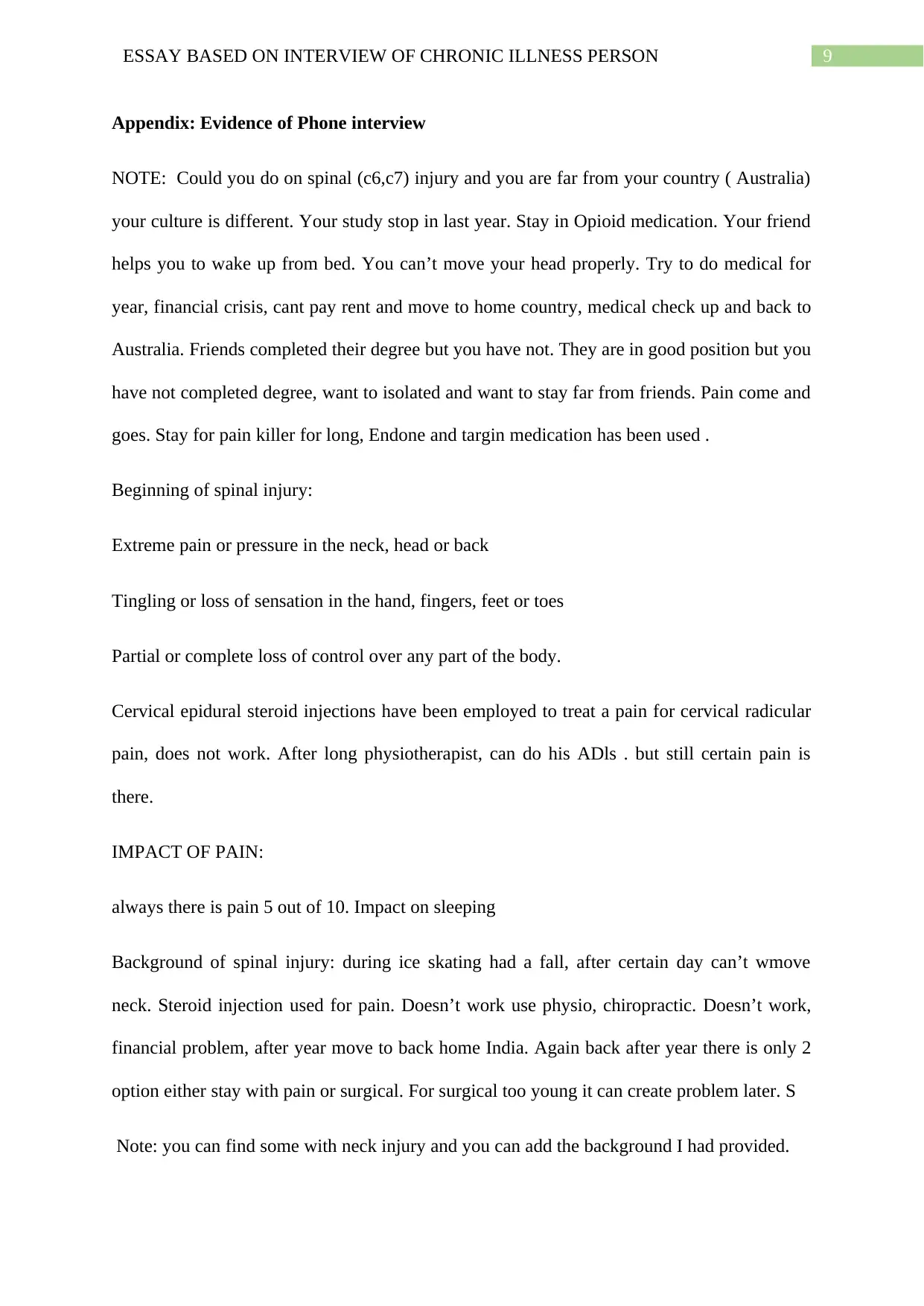
9ESSAY BASED ON INTERVIEW OF CHRONIC ILLNESS PERSON
Appendix: Evidence of Phone interview
NOTE: Could you do on spinal (c6,c7) injury and you are far from your country ( Australia)
your culture is different. Your study stop in last year. Stay in Opioid medication. Your friend
helps you to wake up from bed. You can’t move your head properly. Try to do medical for
year, financial crisis, cant pay rent and move to home country, medical check up and back to
Australia. Friends completed their degree but you have not. They are in good position but you
have not completed degree, want to isolated and want to stay far from friends. Pain come and
goes. Stay for pain killer for long, Endone and targin medication has been used .
Beginning of spinal injury:
Extreme pain or pressure in the neck, head or back
Tingling or loss of sensation in the hand, fingers, feet or toes
Partial or complete loss of control over any part of the body.
Cervical epidural steroid injections have been employed to treat a pain for cervical radicular
pain, does not work. After long physiotherapist, can do his ADls . but still certain pain is
there.
IMPACT OF PAIN:
always there is pain 5 out of 10. Impact on sleeping
Background of spinal injury: during ice skating had a fall, after certain day can’t wmove
neck. Steroid injection used for pain. Doesn’t work use physio, chiropractic. Doesn’t work,
financial problem, after year move to back home India. Again back after year there is only 2
option either stay with pain or surgical. For surgical too young it can create problem later. S
Note: you can find some with neck injury and you can add the background I had provided.
Appendix: Evidence of Phone interview
NOTE: Could you do on spinal (c6,c7) injury and you are far from your country ( Australia)
your culture is different. Your study stop in last year. Stay in Opioid medication. Your friend
helps you to wake up from bed. You can’t move your head properly. Try to do medical for
year, financial crisis, cant pay rent and move to home country, medical check up and back to
Australia. Friends completed their degree but you have not. They are in good position but you
have not completed degree, want to isolated and want to stay far from friends. Pain come and
goes. Stay for pain killer for long, Endone and targin medication has been used .
Beginning of spinal injury:
Extreme pain or pressure in the neck, head or back
Tingling or loss of sensation in the hand, fingers, feet or toes
Partial or complete loss of control over any part of the body.
Cervical epidural steroid injections have been employed to treat a pain for cervical radicular
pain, does not work. After long physiotherapist, can do his ADls . but still certain pain is
there.
IMPACT OF PAIN:
always there is pain 5 out of 10. Impact on sleeping
Background of spinal injury: during ice skating had a fall, after certain day can’t wmove
neck. Steroid injection used for pain. Doesn’t work use physio, chiropractic. Doesn’t work,
financial problem, after year move to back home India. Again back after year there is only 2
option either stay with pain or surgical. For surgical too young it can create problem later. S
Note: you can find some with neck injury and you can add the background I had provided.
Paraphrase This Document
Need a fresh take? Get an instant paraphrase of this document with our AI Paraphraser
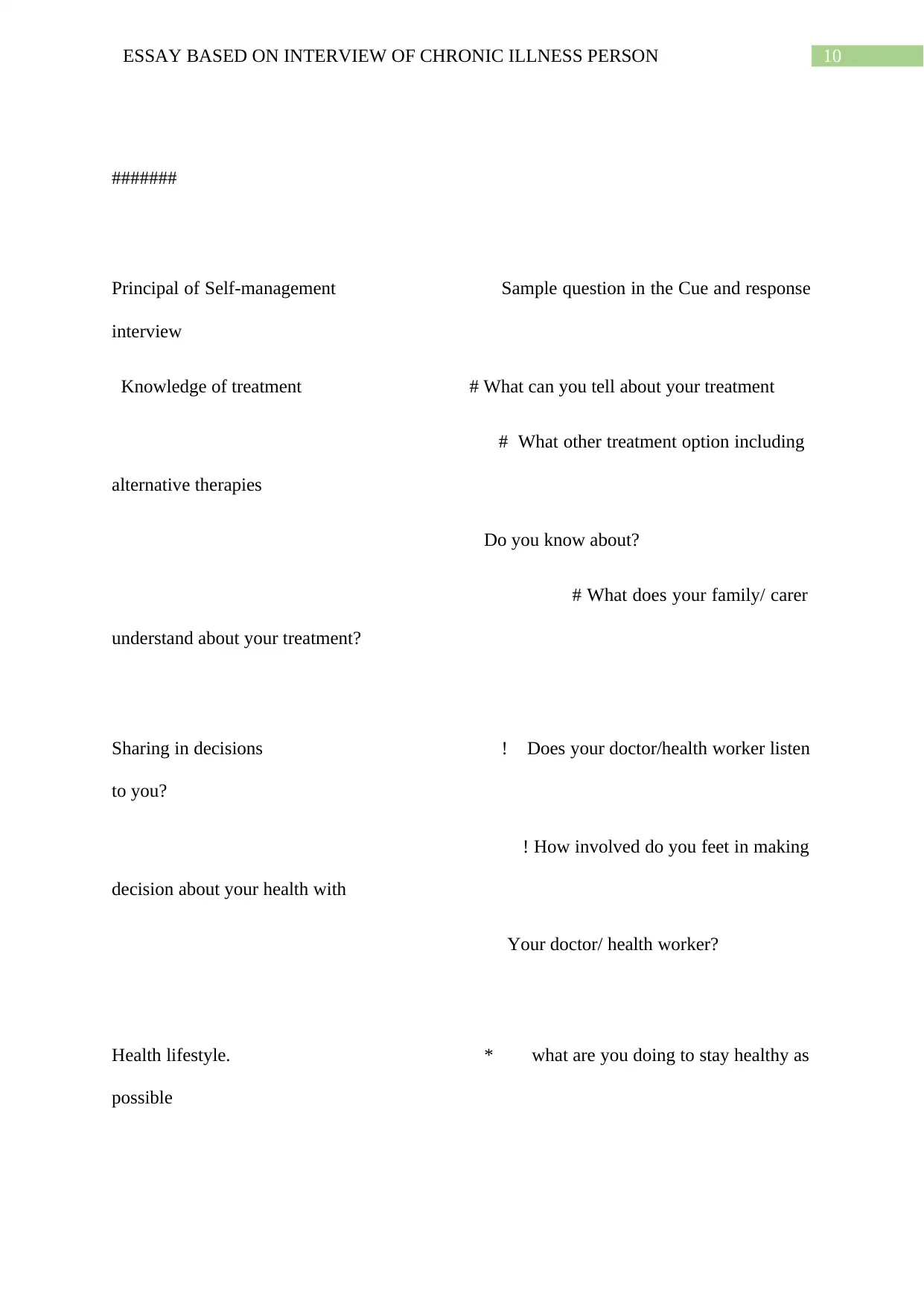
10ESSAY BASED ON INTERVIEW OF CHRONIC ILLNESS PERSON
#######
Principal of Self-management Sample question in the Cue and response
interview
Knowledge of treatment # What can you tell about your treatment
# What other treatment option including
alternative therapies
Do you know about?
# What does your family/ carer
understand about your treatment?
Sharing in decisions ! Does your doctor/health worker listen
to you?
! How involved do you feet in making
decision about your health with
Your doctor/ health worker?
Health lifestyle. * what are you doing to stay healthy as
possible
#######
Principal of Self-management Sample question in the Cue and response
interview
Knowledge of treatment # What can you tell about your treatment
# What other treatment option including
alternative therapies
Do you know about?
# What does your family/ carer
understand about your treatment?
Sharing in decisions ! Does your doctor/health worker listen
to you?
! How involved do you feet in making
decision about your health with
Your doctor/ health worker?
Health lifestyle. * what are you doing to stay healthy as
possible
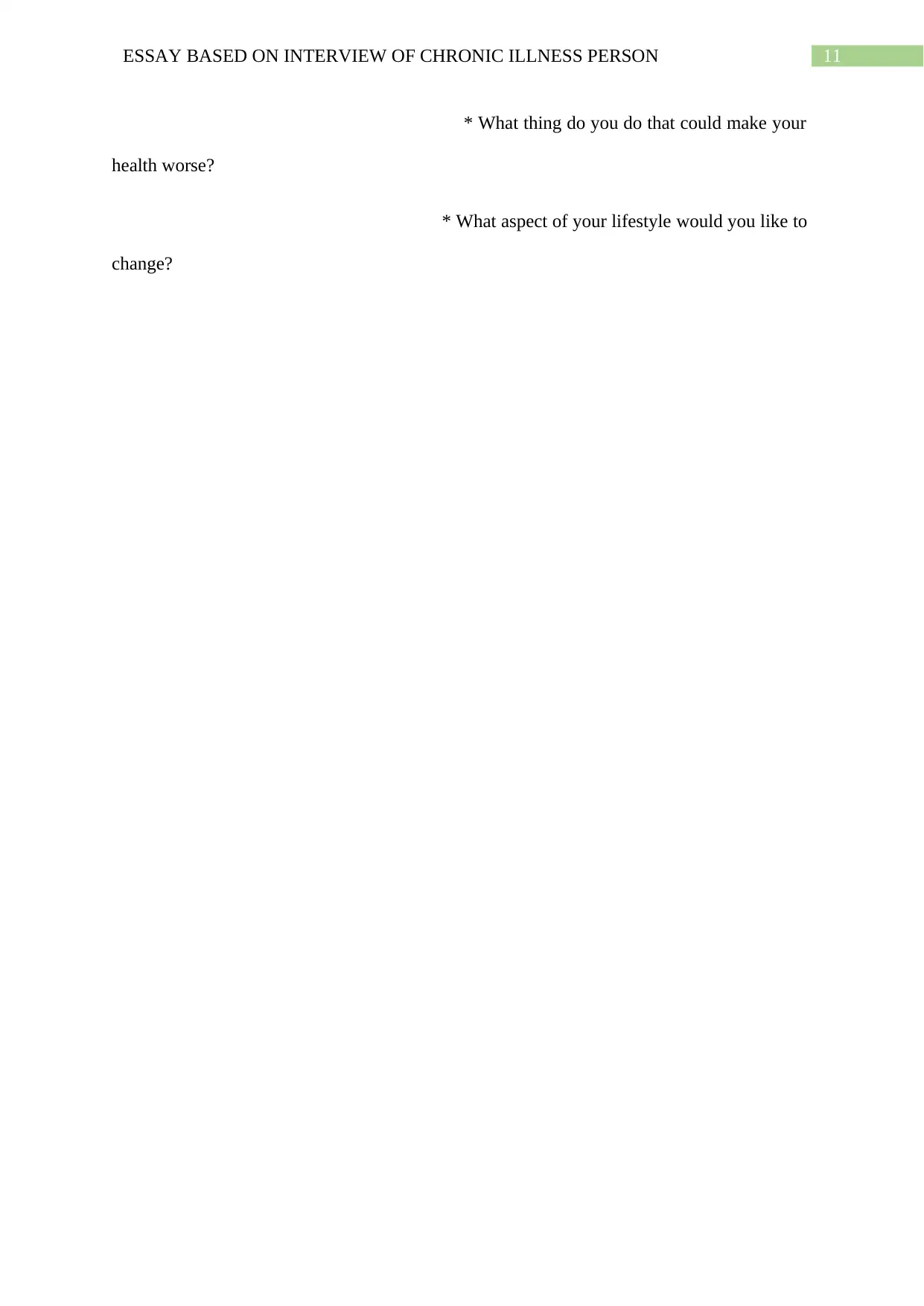
11ESSAY BASED ON INTERVIEW OF CHRONIC ILLNESS PERSON
* What thing do you do that could make your
health worse?
* What aspect of your lifestyle would you like to
change?
* What thing do you do that could make your
health worse?
* What aspect of your lifestyle would you like to
change?
⊘ This is a preview!⊘
Do you want full access?
Subscribe today to unlock all pages.

Trusted by 1+ million students worldwide
1 out of 12
Related Documents
Your All-in-One AI-Powered Toolkit for Academic Success.
+13062052269
info@desklib.com
Available 24*7 on WhatsApp / Email
![[object Object]](/_next/static/media/star-bottom.7253800d.svg)
Unlock your academic potential
Copyright © 2020–2025 A2Z Services. All Rights Reserved. Developed and managed by ZUCOL.




